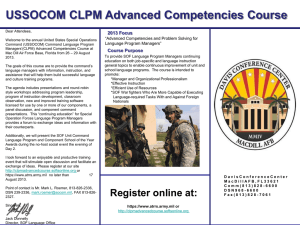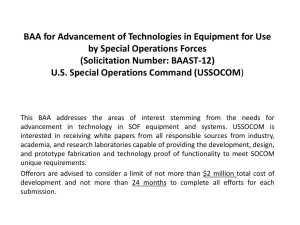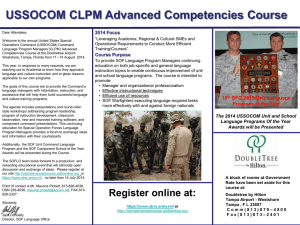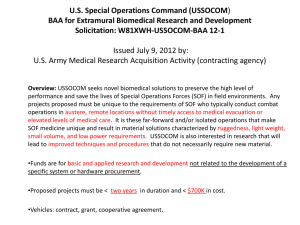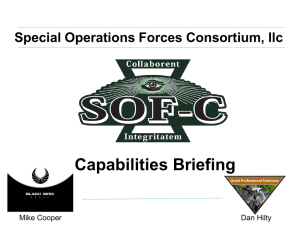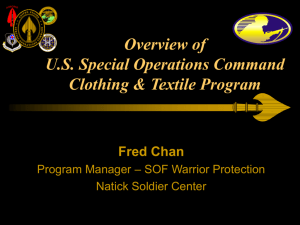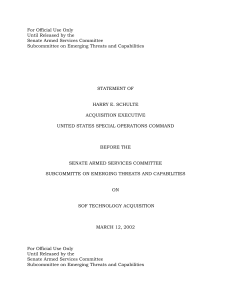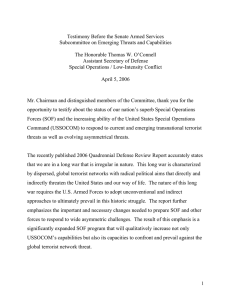FOR OFFICIAL USE ONLY UNTIL RELEASED BY THE SUBCOMMITTEE ON TERRORISM,
advertisement
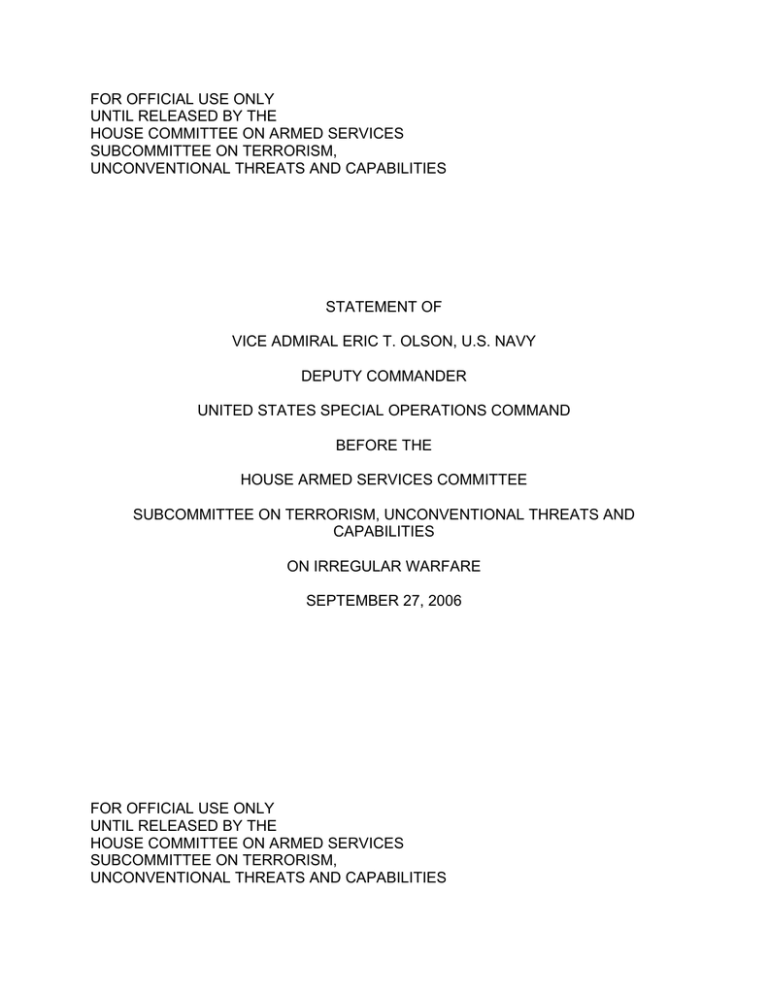
FOR OFFICIAL USE ONLY UNTIL RELEASED BY THE HOUSE COMMITTEE ON ARMED SERVICES SUBCOMMITTEE ON TERRORISM, UNCONVENTIONAL THREATS AND CAPABILITIES STATEMENT OF VICE ADMIRAL ERIC T. OLSON, U.S. NAVY DEPUTY COMMANDER UNITED STATES SPECIAL OPERATIONS COMMAND BEFORE THE HOUSE ARMED SERVICES COMMITTEE SUBCOMMITTEE ON TERRORISM, UNCONVENTIONAL THREATS AND CAPABILITIES ON IRREGULAR WARFARE SEPTEMBER 27, 2006 FOR OFFICIAL USE ONLY UNTIL RELEASED BY THE HOUSE COMMITTEE ON ARMED SERVICES SUBCOMMITTEE ON TERRORISM, UNCONVENTIONAL THREATS AND CAPABILITIES STATEMENT OF VICE ADMIRAL ERIC T. OLSON, U.S. NAVY DEPUTY COMMANDER UNITED STATES SPECIAL OPERATIONS COMMAND Chairman Saxton, Representative Meehan, distinguished Members of the Committee, I am honored to report to you today on the continuing efforts of the Department of Defense (DoD) and the U.S. Special Operations Command (USSOCOM) to improve and institutionalize our approaches and methodology for conducting and countering Irregular Warfare (IW). The Department’s current working definition of IW refers to “a form of warfare that has as its objective the credibility and/or legitimacy of the relevant political authority with the goal of undermining or supporting that authority.” IW often employs indirect approaches to gain asymmetric advantages over an adversary, and special operations forces (SOF) have long excelled in many IW tasks. Unconventional warfare, counterterrorism, counter-insurgency, civil-military operations, psychological operations, and foreign internal defense are all traditional special operations core activities. IW is not a new mission, but rather a new way to think about, describe, and categorize various threats and adversaries we currently face, or are likely to face in the future – threats not best suited to traditional military operations. IW is also a set of activities that U.S. forces, both SOF and non-SOF, can incorporate into their approach to countering threats. IW synthesizes indirect and direct methods. It brings all elements of U.S. power to bear on a problem in a synchronized and coordinated manner. Throughout their history, special operations forces have combined direct and indirect methods, and have partnered with others to accomplish the mission at hand. This mindset has enabled SOF to gain access, build relationships, foster influence, and take or support direct action when necessary. USSOCOM understands that, as important as direct actions are in IW, many equally carefully planned, less visible indirect actions are at least as decisive in their impact. SOF are performing indirect actions in every region of the world, with real results in the Global War on Terror. Missions such as foreign counterpart training, civil-military operations, information distribution, infrastructure development, and the development of medical, dental, and veterinary clinics may not get the same headlines as the death or capture of a key Al Qaeda leader, but they are essential elements of IW. At remote base camps in the Philippines, Afghanistan, Columbia, Iraq, and elsewhere, small elements of special operators are working with their hosts and counterparts to help establish the conditions to disrupt and defeat terrorism. Operating a radio station that transmits true messages that counter terrorist disinformation; building roads, piers, bridges, and water systems to enable local economies to thrive; training indigenous security forces to perform their duties and gain the trust of their constituents – these are a few of the important missions SOF are performing today. Although we are underrepresented in some areas of the world, once the Quadrennial Defense Review (QDR) directed growth occurs, SOF will be better postured to establish the conditions to counter and defeat terrorism around the globe. USSOCOM and its subordinate commands will continue to play a key role in planning and executing IW operations. The general purpose forces of the military Services are doing the same, and we are working closely with them as we strive to match the most efficient and effective force to each mission. Many factors may preclude or restrain a joint force from conducting conventional military campaigns. These situations will require or favor an irregular military approach, using indirect and often non-traditional methods to achieve U.S. strategic objectives. IW will become an increasingly attractive strategic option and perhaps a preferred means for the U.S. to influence, deter, or defeat hostile states, occupying powers, and nonstate adversaries. At the same time, the defensive use of IW will help keep in check those who wish to do us or our friends or allies harm. SOF are organized, trained, educated, equipped, and manned to conduct IW. We conduct constant self-assessment to ensure that lessons learned in operational environments are incorporated back into our training and education, and operational planning and execution. The curricula at our schoolhouses have been tailored to our more immediate threats, and this adjustment will continue. As part of a larger DoD process of re-tooling our forces to better face today’s and tomorrow’s threats, USSOCOM has been actively engaged in the execution of the Department’s Irregular Warfare Roadmap. To improve the capabilities of the joint force to plan and execute IW, USSOCOM is co-authoring a Joint Operating Concept (JOC) for IW which should be complete by the end of the year. The purpose of the IW Joint Operating Concept is to broadly describe how joint force commanders will conduct protracted IW to accomplish national objectives on a regional level or global scale. The IW Joint Operating Concept will apply across the full range of military operations and result in a more balanced DoD approach to conflict. The concept will also provide guidance for force development that could result in changes to doctrine, organization, training, materiel, leader development and education, personnel and facilities. Another important task being pursued within the IW Roadmap is identifying which IW tasks should be handed off from SOF to the general purpose forces. This will codify an assessment process to ensure that capable forces, whether conventional forces or SOF, are conducting each IW mission. Increasing the IW capabilities of the general purpose forces will serve to increase the availability of SOF to perform activities for which they are specially trained and equipped. In summary, the Department, USSOCOM and the Services are improving their postures to both conduct and combat Irregular Warfare. We are dedicated to improving the ability of the U.S. to do so by having the right forces in the right place at the right time, always with the right training and the right equipment. I thank the distinguished members of this subcommittee for your important role in enabling us to do just that, and I very much appreciate the opportunity to be with you here today. This concludes my prepared remarks, and I am available to answer any questions you may have.
